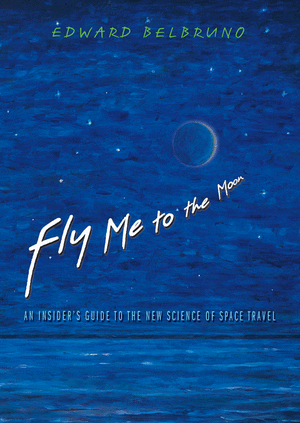Foreword: Fly Me to the Moon
From Fly Me to the Moon by Edward Belbruno.

Sometimes, history comes fast.
A mere 65 years, 7 months, 3 days, 5 hours, and 43 minutes after Orville Wright left the ground on the first-ever powered flight, Neil Armstrong, the commander of Apollo 11, uttered his first comment from the Lunar surface, “Houston, Tranquility Base here. The Eagle has landed.”
Of course the Wright Brothers’ 1903 “aero” plane was heavier than air. Their new fangled machine would be quite useless across the quarter-million-mile airless gap between Earth and the Moon, as would every airplane invented and designed since. So the Apollo missions cannot be considered the natural extension of tinkering with winged craft, even though the lunar module of Apollo 11 was named for a bird.
In the era before heavier-than-air flight, there was lighter-than-air flight. Back when drifting slowly through Earth’s atmosphere in the gondola of a hot air balloon was all the rage in the western world. To move effortlessly with the breeze was not enough for Jules Verne, the celebrated visionary and science fiction writer. Instead, he set the Moon in his sights, and knew that such an airless journey precluded the use of balloons and other imagined flying machines of the day. And so he proposed in his 1865 novel From the Earth to the Moon that this first trip, taken by three men, two dogs, and some chickens, would require a means of moving without the buoyancy of air. So he loaded his spacefarers into a large bullet-shaped shell, and fired them out of an enormous gun; not unlike the circus performer who gets shot from a cannon to an awaiting net.
Verne badly underestimated the effect on the human body of explosively accelerating from zero miles per hour to Earth’s escape velocity of seven miles per second. At the rate given, the three Moon voyagers and their animal companions would have become instantly pinned to the rear of the ship, and then crushed by the “g” forces into a pile of goo.
Carnage notwithstanding, the real message here is that, to Jules Verne and to the readers of his best-selling book, the Moon was not simply a cosmic object hovering at an unreachable distance. The Moon was a destination. The Moon was a world to be explored, with no less curiosity than one might carry to a distant mountain range, or to the far side of the ocean.
Curiosity. Humans have never been without it. Who knows what thoughts course through the mind of other animals when they look up to the night sky. First, do they look up at all? And if they do, then do they wonder what’s up there? Do any of them share our thoughts of adventure, as we stand on Earth’s surface and feel the call of the cosmos? I doubt it. But even if they did, not only can we dream it, we can do something about it.
No, you can’t (or rather, shouldn’t) catapult complex living matter such as humans through space inside of oversized bullets fired through humongous cannons. You can, however, send people in rockets—an innovation that would await the creative efforts of American Engineer Robert Goddard, who, in the 1920s pioneered liquid fuel propulsion. Upon the success of his rocket, especially the versions where you can throttle the thrust, thereby softening the the g-forces on the occupants, Goddard immediately recognized the value of such a discovery for a Moon voyage, but was saddened by what would surely be the prohibitive cost of such a trip, lamenting that, “it might cost a million dollars.”
Goddard was indeed a better engineer than economist: in modern dollars, that’s about the cost of ten hour’s time of the space shuttle in orbit.
Isaac Newton’s law of gravity tells us that all cosmic objects pull on you at all times: the Sun, the Moon, Earth, the other planets, the stars. And since everybody is in motion—in orbit around somebody else—your detailed trajectory through space can, and will be, quite complex. So, perhaps, we should not be surprised that people are still figuring out clever ways to maneuver around the solar system. One of my favorites is the gravitational slingshot. Seems that today, with slim budgets, hardly any space probe has enough fuel to reach its destination without the help of another planet’s gravity. The Galileo space probe to Jupiter, for example, required a three-planet gravity assist: first Venus, then Earth, and then Earth again, before heading for the outer solar system—a move that remains the envy of billiard enthusiasts.
Another of my favorites comes from a web of spooky, interconnected zones among the planets and their moons, where the sum of all forces is small, if not zero. Under these conditions, motion is practically effortless as you drift slowly through space. Barely understood until recently, and hardly explored until the work of Ed Belbruno, these newly discovered interplanetary highways offer a romantic reflection of the pre-rocket, pre-airplane era, where balloons would transport us, with hardly any energy of our own, from one unexplored terrain to another.

